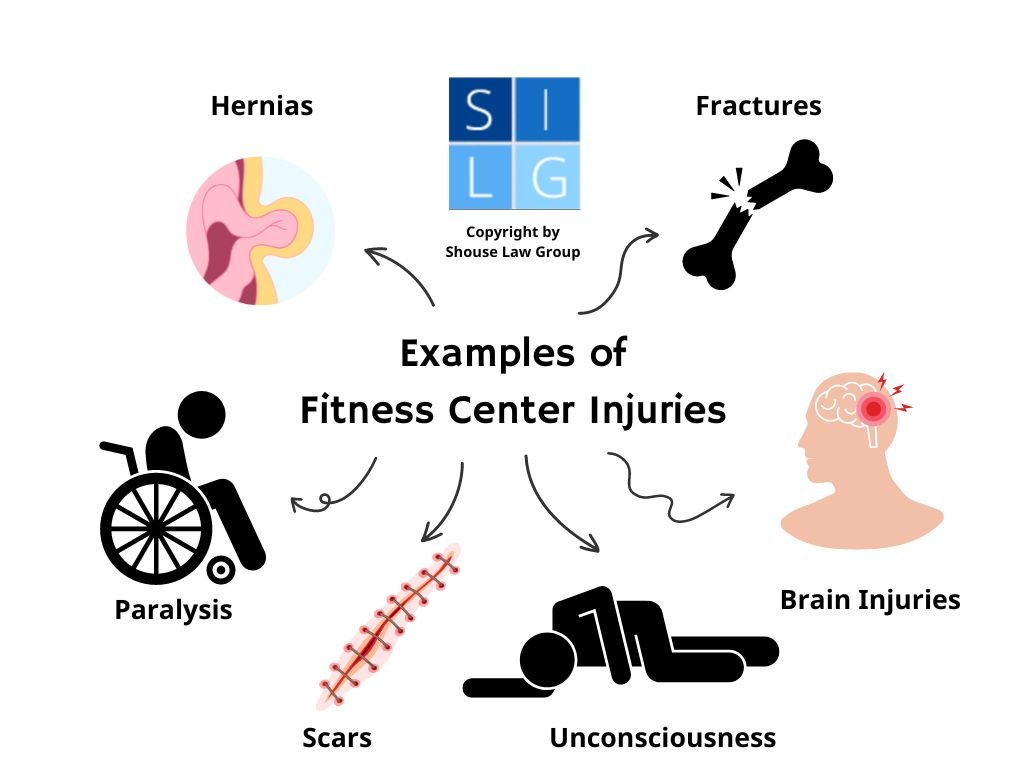
In the United States, 409,224 people were hurt by exercise equipment in 2021 alone. Nearly 10% of these accidents were fatal.
If you were hurt by faulty gym equipment, you can bring a product liability lawsuit against the equipment company. In some cases, you can also sue the gym if it negligently assembled, installed, or maintained the devices.
How can faulty gym equipment cause an injury?
Defective workout equipment can be dangerous in a wide variety of ways, including:
- treadmills that go faster than they should or that stop abruptly,
- exercise bikes that are not sturdy and that break or fall over while in use,
- exercise machines that use belts or pulleys that fray and break,
- weight machines that have their “dead-stop” safety mechanism set too low, and
- ellipticals with faulty wiring that gives electrical shocks.1
The following graphic shows common fitness center injuries from faulty equipment.

Who can I sue?
Depending on the circumstances of your case, you can file a personal injury claim against:
- the company behind the faulty gym equipment, and/or
- the gym or fitness center.
We have found that filing claims against both of them is often wise. As evidence is gathered and it becomes clearer which party is at fault, they will already be in the lawsuit. Additionally, their attempts to blame the other for your injuries can lead to discovering evidence that strengthens your case.
Suing for Products Liability
A gym injury lawsuit against the company behind the gym equipment would be based on product liability. It would claim that the gym equipment was a defective product because it was either:
- defectively designed, which means it was not as safe as an ordinary consumer would expect if used in a reasonably foreseeable way; or
- defectively manufactured, which means that the finished product had a defect that varied from the intended design; or
- defectively marketed, which means the manufacturer failed to adequately warn users of known potential harms that could be encountered by using the equipment correctly.
If there was any of these defects in the gym equipment that hurt you, the company can be held strictly liable for your injuries.2
Suing for Negligence
If you were injured by faulty gym equipment, you may also be able to bring a negligence lawsuit against the fitness facility for failing to:
- correctly install and maintain the equipment,
- warn you of any non-obvious hazards, or
- call for help soon enough after you got injured.
In short, your lawsuit would argue that the gym’s breach of its duty of care to protect you from harm resulted in you getting injured.3
What compensation can I get?
If you bring a lawsuit for injuries from faulty gym equipment, you can sue for:
- medical bills,
- lost wages,
- lost future earnings, and
- pain and suffering.
If your family member suffered a fatal gym injury, you can file a wrongful death lawsuit seeking burial expenses and loss of financial support.
Because most companies are insured, the compensation from a legal action would be paid out by an insurance company.
What if I was partially at fault?
Nearly all states use some form of comparative negligence, where jurors assign you a percentage of fault for your gym injuries. The financial compensation you are awarded would then be reduced by your percentage of fault.
In states like Florida and California, your compensation would be reduced by your percentage of fault no matter how responsible you were for your injuries. In states like Nevada, your compensation would also be reduced by your percentage of fault, but you would be barred from recovering anything if you were more than half at fault.4
What if I signed a liability waiver?
Most gyms and fitness centers require you to sign a liability waiver to use the equipment. By signing it, you accept the assumption of risk and agree to hold the facility harmless for its negligence.
However, we may be able to show the waiver is unenforceable. If not, you would still be able to sue for injuries caused by the gym’s:
Five Steps to Take After a Gym Accident
- Get medical attention. Even if you do not feel hurt, you may have an injury that takes time to manifest.
- Photograph the faulty equipment and your injuries. This could serve as vital evidence in a lawsuit.
- Get the contact information of eyewitnesses. They could back up your story if the gym claims you were at fault.
- DO NOT ADMIT FAULT. Any admission could hinder your ability to recover damages.
- Call a California personal injury attorney. Concentrate on healing while your lawyer fights for the highest settlement possible.
Additional Reading
For more in-depth information, refer to these scholarly articles:
- Safety Lessons Learned from Strength and Conditioning Negligence Lawsuits – ACSM’s Health & Fitness Journal.
- Preparing Recreational Sports Professionals for a Litigious Society – Recreational Sports Journal.
- Resistance Training and Litigation – ACSM’s Health & Fitness Journal.
- Court Cases Involving Recreational Professionals – Recreational Sports Journal.
- Weight Room Litigation What’s It All About? – Strength and Conditioning Journal.
Legal References
- How Common Are Exercise Equipment Injuries? Safer America (May 10, 2023). See also NEISS Data Highlights – Calendar Year 2019.
- Anderson v. Owens-Corning Fiberglas Corp. (1991) 53 Cal.3d 987. Barker v. Lull Engineering Co. (1978) 20 Cal.3d 413
- California Civil Jury Instructions CACI 400.
- Florida Statutes 768.81. Li v. Yellow Cab Co. (1975) 13 Cal.3d 804. NRS 41.141.

